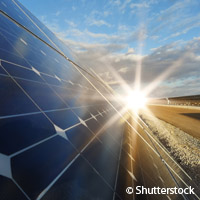More energy for EU researcher in photovoltaics
European research in renewable energy has received an additional boost with the recent commencement of the KESTCELLS research project. With a total budget of more than EUR 3.7 million it aims to develop a network for the interdisciplinary training of researchers in advanced thin films photovoltaic (PV) technologies. The researchers believe that their research will provide Europe with leading edge technologies in the area of solar cells, ensuring its global dominance and increasing its competitiveness of existing technologies. In particular the KESTCELLS project proposes the development of new technologies which will be compatible with the requirements that are needed to become a reliable and future alternative to conventional non renewable energy sources. These requirements include the need to be cost effective, efficient, sustainable and the capacity to be mass produced. The project believes that the key to achieving all of these needs may achieved with a mineral known as kesterite. As a result the network will target its efforts on the development of kesterite based solar cells. Professor Susanne Siebentritt, head of the Laboratory for Photovoltaics, Physics Research Unit will lead the team from the University of Luxembourg whose task it will be to examine the basic semiconductor physics of new materials used in solar cells. 'We are looking at developing PV technologies based on kesterite material, a mineral heavy in copper and zinc, to meet the cost, efficiency and sustainability requirements for mass production of solar cells needed for solar energy', explains Prof. Siebentritt. 'With this training network we can keep Europe on the path to being a leader in solar energy', she continues. From the outset the team has already identified that a lack of professionals with these competences is one of the main risks for the future development and consolidation of a competitive European PV sector. What is so attractive about the new materials is that they have a high potential for low cost thin film PV technologies, as kesterites are formed by abundant and cheap elements. The project proposes the development of PV technologies based on kesterite, and processes compatible with the efficiency requirements needed to become a reliable and future alternative to conventional non-renewable energy sources. According to the researchers, by creating such a high calibre network of researchers, they will ensure the strategic development of PV technologies in Europe. They point out that such a scheme is in accordance with the objectives described by the Technology Roadmap for PV Energy of the European Commission. In order to accomplish the overall aims of the project, twelve doctoral students and two postdocs will be trained over the course of the project. They will be taught various aspects which are related to fundamental materials science, advanced growth techniques in thin film technologies, techniques for advanced characterisation and process monitoring, modelling and design of devices, as well as aspects related to the innovation and industrial implementation of production lines and market analysis. Susanne Siebentritt is also part of the Organising Committee and the Scientific Committee of the 3rd European Kesterite Workshop held in Luxembourg on the 22 and 23 November. The aim of the workshop is to bring together experts working on kesterite solar cells from all over Europe. Professors and researchers will discuss the growth of kesterite films and crystals, electronic and structural properties of kesterite materials and solar cell structure and characterisation. During the conference a wide range of topics will be covered including, Growth of kesterite films and crystals, Electronic and structural properties of kesterite materials and Device structure and characterisation.For more information, please visit: KESTCELLSHttp://www.kestcells.euUniversity of Luxembourghttp://wwwen.uni.lu
Countries
Luxembourg



